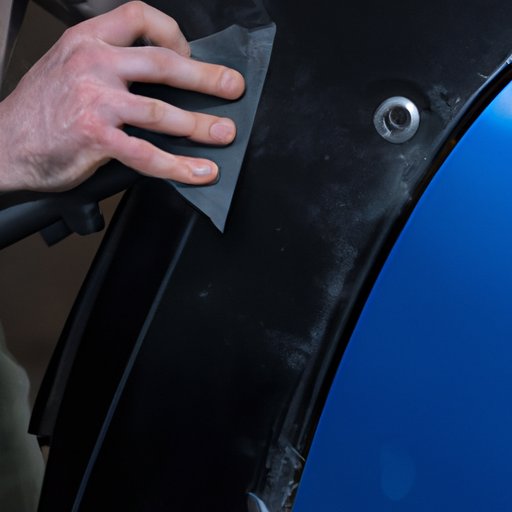
Introduction
Seeing a dent on your car can be frustrating, especially if you are unsure of how to fix it. Dents can happen for a variety of reasons, from accidents to weather to vandalism, and fixing them is important not just for cosmetic reasons, but also to maintain the value of your vehicle.
In this article, we will provide you with a comprehensive guide on how to fix a dent in your car. We will cover traditional methods, DIY techniques using household items, professional repairs, paintless dent repair, and even innovative techniques.
Step-by-Step Guide
The traditional method of fixing a dent involves several steps, including:
- Clean the area around the dent to remove any dirt or debris.
- Heat the dented area with a hairdryer for a few minutes if possible. This will make the metal more pliable.
- Use a plunger or a vacuum cleaner to suction onto the dent and pull it outwards. Make sure to use the right technique since too much force can worsen the damage to the car.
- If the dent is deep or complex, hammer it back into place using a rubber mallet.
- Smooth out the dent by sanding it and applying filler if necessary.
- Finish by painting the car to match the original color and making the repair blend in seamlessly with the rest of the car.
You will need several tools for this process, including a plunger, vacuum cleaner, rubber mallet, hairdryer, sandpaper, filler, and paint. Make sure to be patient and follow the steps closely for the best results.
Using Household Items
If you want to try a DIY approach to fix a dent, you can use household items like boiling water, a vacuum cleaner, or a plunger. These methods can offer a less expensive and convenient solution for smaller dents.
Boiling water can be used to soften the metal before trying to push it back into place. You can pour hot water on the dented area, and then use a plunger to suction the dent outwards. You can also use a vacuum cleaner by creating a seal around the dent with the nozzle and then pulling the dent out.
While these methods can be effective, they do have limitations and may not work for larger or more complex dents. It is also important to be careful when using DIY methods since too much force can cause further damage to your car.
Professional Fix
If you want a premium quality repair, taking your car to a professional repair shop can be the best option. A trustworthy and experienced repair shop can deliver high-quality results and ensure that your car looks like new again.
When choosing a repair shop, consider factors like their reputation, experience, and pricing. Look for reviews from previous customers and ask for references if possible. Choose a shop that specializes in your car model, and make sure that they offer a warranty.
Paintless Dent Repair
Paintless dent repair is a popular technique used by professionals that can be less invasive than traditional methods. This method involves massaging the dent out from the inside using special tools and techniques, hence keeping the original paint job intact.
Paintless dent repair is best employed for smaller and shallower dents that are in an accessible location on the car. It is also a faster and less expensive option than traditional repairs since it does not involve painting the car.
When looking for a professional who offers this service, make sure to ask about their experience with paintless dent repair and consider getting a few quotes to compare pricing.
Prevention Tips
Prevention is key when it comes to avoiding dents altogether. Here are some tips:
- Park in a safe location and avoid parking next to other cars in crowded parking lots.
- Be cautious of opening car doors around other parked vehicles or solid objects.
- Drive carefully to avoid collisions with other cars, animals, and objects.
- Keep your car in good condition by regularly washing and waxing it to protect it against weather conditions and debris.
Common Causes of Dents
Some common causes of dents include:
- Car accidents
- Hailstorms and other severe weather conditions
- Vandalism
- Everyday wear and tear
Avoiding these conditions is often not an option, which makes prevention measures and prompt treatment essential to dent repair.
Innovative Techniques
If you are feeling daring, you can try some unconventional methods like using dry ice or boiling water to remove dents. Dry ice has been known to work by causing the metal to contract, while boiling water works by expanding the metal and allowing it to pop back into place naturally.
However, it is advisable only to try these methods for smaller dents since extensive or complicated dents will require more in-depth repair and specialists.
Conclusion
Fixing a dent in your car may seem daunting, but there are various methods available to suit every budget, time-frame, and level of DIY expertise. Whether you go for a traditional method or a professional approach, make sure to follow the required steps and take appropriate care in every repair attempt.
Prevention is key to avoiding dents and maintaining your car’s value. Make sure to follow the guidelines provided, such as parking in safe areas and driving carefully.
Remember that fixing a dent can maintain your car’s value and restoring it aesthetically. It shows that you value your vehicle while preventing your car from rusting.





